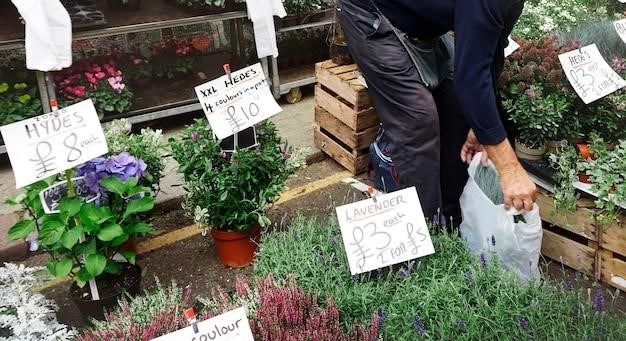Understanding USDA Plant Hardiness Zone 10
USDA Plant Hardiness Zone 10 boasts mild winters (30-40°F) and warm summers, ideal for diverse plant life․ This zone, encompassing parts of Florida, Texas, and California, offers a long growing season and high humidity․ Successful gardening requires selecting plants suited to this subtropical climate and utilizing appropriate techniques․
Defining Zone 10a and 10b
Within USDA Plant Hardiness Zone 10, further distinctions exist⁚ Zone 10a and Zone 10b․ These sub-zones refine the temperature ranges, providing a more precise guide for plant selection․ Zone 10a experiences average minimum winter temperatures between 30 and 35°F (-1․1 and 1․7°C), while Zone 10b enjoys slightly warmer conditions, ranging from 35 to 40°F (1․7 and 4․4°C)․ This seemingly small difference significantly impacts the types of plants that will thrive․ Understanding this distinction is crucial for gardeners in Zone 10, ensuring the success of their plantings․ While both sub-zones share a subtropical climate, the variations in minimum temperatures necessitate careful consideration when choosing plants․ For example, some tropical species might flourish in 10b but struggle to survive the slightly cooler nights of 10a․ Consult detailed plant descriptions to determine suitability for your specific sub-zone․
Average Minimum Temperatures and Climate
Zone 10’s defining characteristic is its mild winter temperatures, averaging between 30°F (-1․1°C) and 40°F (4․4°C)․ This range, however, is further divided into the sub-zones 10a and 10b, reflecting subtle but important temperature variations․ The climate is predominantly subtropical, characterized by warm to hot summers and relatively high humidity․ The frost-free period extends for a significant portion of the year, typically from late January to early December, though microclimates can influence these dates․ Coastal areas within Zone 10 may experience milder temperatures and less extreme variations than inland locations․ This variation in microclimates can affect plant selection, as some species prefer the more moderate conditions of coastal regions while others thrive in the warmer, potentially drier inland areas․ Understanding these climatic nuances is essential for achieving optimal plant growth and minimizing losses due to unexpected cold snaps or excessively hot conditions․ Careful observation of your specific location’s temperature patterns is strongly recommended․
Ideal Plants for Zone 10
Zone 10’s warm climate supports a wide array of plants, including tropicals, succulents, and many flowering perennials and shrubs․ Careful selection based on sun exposure and soil type is key to success․
Top Perennials for Zone 10
Zone 10’s extended growing season and mild winters make it perfect for a wide variety of perennials․ Sun-loving choices include robust varieties like Hibiscus, known for their large, showy flowers in vibrant colors, and Coneflowers (Echinacea), attracting pollinators with their daisy-like blooms; For those seeking elegant options, consider Irises, offering a diverse range of colors and textures, and Daylilies (Hemerocallis), valued for their ease of care and long blooming period․ If you prefer a more delicate aesthetic, Lantana, a sprawling plant with clusters of small flowers, adds a touch of vibrancy, while Asters bring a late-season burst of color․ Remember to select varieties suited to your specific microclimate and soil conditions within Zone 10 for optimal results․ Consider the mature size of each plant to ensure proper spacing in your garden design․
Best Shrubs for Zone 10 Gardens
Zone 10’s warm climate allows for a stunning array of shrubs to thrive․ Abelia, a low-maintenance option, offers colorful foliage and fragrant blooms extending from spring to fall․ For a burst of color, consider Azaleas, adaptable shrubs with a variety of flower colors and forms․ If you appreciate texture and visual interest, Bougainvillea, with its vibrant bracts, creates a striking focal point, although it may require pruning to maintain its shape․ For a more tropical feel, Croton shrubs provide bold foliage in a range of colors, adding a dynamic element to your garden․ When selecting shrubs, consider mature size and sun exposure requirements․ Many Zone 10 shrubs prefer well-drained soil and regular watering, especially during extended dry periods․ Remember to research specific varieties to find those best suited to your microclimate and aesthetic preferences․ Incorporate a mix of heights and textures to create visual depth and interest in your landscape․
Recommended Trees for Zone 10 Landscapes
Zone 10’s warm climate supports a wide variety of trees, offering diverse options for landscaping․ The Royal Poinciana (Delonix regia), with its flamboyant scarlet flowers, makes a bold statement, though it requires ample space․ For a unique texture and architectural presence, the Monkey Puzzle (Araucaria araucana) offers an unusual, eye-catching form․ If you prefer something more understated, the Strawberry Tree (Arbutus unedo) provides year-round interest with its attractive bark and edible berries․ Consider the mature size of any tree before planting to ensure it fits comfortably within your landscape․ Before selecting your trees, evaluate your soil conditions, as some trees prefer well-drained soil while others tolerate heavier clay․ Proper watering is crucial, especially during establishment․ Remember that some trees are faster growing than others, impacting the overall design timeline of your landscape․ Research individual species to understand their specific needs and ensure a successful integration into your Zone 10 garden․

Zone 10 Planting Guide⁚ Seasonal Considerations
Zone 10’s long, warm growing season allows for diverse planting schedules․ Spring and fall offer ideal planting windows, while summer requires careful watering and sun protection․ Adjust planting based on specific plant needs and local microclimates․
Spring Planting in Zone 10
Spring in Zone 10, typically starting in late January and lasting until early June, presents an ideal time for planting a wide array of annuals, vegetables, and warm-season crops․ The soil has warmed sufficiently, and the risk of frost has significantly diminished, creating a favorable environment for vigorous growth․ Many gardeners begin sowing seeds directly into the ground, while others opt for transplanting seedlings started indoors․ Popular choices for spring planting include heat-loving vegetables such as tomatoes, peppers, and cucumbers․ Flowering annuals like zinnias, petunias, and marigolds add vibrant color to gardens and landscapes․ Remember to amend the soil with compost or other organic matter to enhance drainage and fertility․ Consistent watering is crucial, especially during dry spells, to ensure successful establishment and healthy plant development․ Regular fertilization will further support optimal growth and flowering․
Summer Gardening in Zone 10
Summer in Zone 10, characterized by long, hot days and high humidity, requires a slightly different approach to gardening․ Maintaining consistent soil moisture is paramount, as plants can quickly dehydrate under intense sun․ Regular watering, ideally in the early morning or evening to minimize evaporation, is essential․ Mulching around plants helps retain soil moisture and suppress weeds․ For vegetable gardens, consider using shade cloth to protect delicate plants from the scorching sun․ Regular monitoring for pests and diseases is crucial; early detection and treatment can prevent widespread problems․ Summer is also a time for harvesting many spring-planted crops and enjoying the bounty of your garden․ Remember to prune back overgrown plants to encourage air circulation and prevent fungal diseases․ Consider planting heat-tolerant plants, such as succulents, which thrive in dry conditions․ During the hottest part of the day, it’s best to avoid working in the garden to prevent heatstroke․
Fall Planting and Bulb Selection
Fall in Zone 10 presents an excellent opportunity for planting many cool-season crops and bulbs․ The milder temperatures and shorter days provide ideal conditions for establishing these plants before the winter months․ Many vegetables, such as beets, broccoli, and kale, can be sown directly into the ground in fall․ Others, like lettuce and spinach, can be started from seed indoors for later transplanting․ Fall is also the perfect time to plant bulbs that will bloom in the winter and spring․ Consider planting tulips, daffodils, hyacinths, and other similar bulbs for a colorful display․ Before planting bulbs, prepare the soil by amending it with compost or other organic matter to improve drainage and fertility․ Ensure proper spacing between bulbs to allow for adequate growth․ Water the newly planted bulbs well to help them establish a strong root system․ Remember to protect tender seedlings and newly planted bulbs from unexpected frost․ With careful planning and execution, your fall planting efforts can significantly enhance your garden’s beauty and productivity in the coming months; Fall planting sets the stage for a vibrant spring garden in Zone 10․

Specific Plant Recommendations
Zone 10’s warm climate supports a wide array of plants․ Consider options like bougainvillea, night-blooming jasmine, and various succulents thriving in full sun․ Native plant choices enhance biodiversity and require less maintenance․
Tropical and Subtropical Options
Zone 10’s warm, humid climate makes it a haven for tropical and subtropical plants․ Consider the vibrant bougainvillea, with its cascading blooms in a variety of colors, adding a splash of intense color to any landscape․ The fragrant night-blooming jasmine, releasing its intoxicating scent under the moonlight, creates a magical ambiance in your garden․ For a unique addition, explore the low-growing pineapple plant, requiring a year to mature but rewarding you with the sweet taste of homegrown fruit․ The papaya tree, often behaving more like a perennial, offers sweet mango-like fruits directly from its trunk; ensure you select a bisexual plant for fruit production․ Bananas, with their lush foliage and sweet fruit, are also viable options, although they might require specific care and protection from frost, even in Zone 10․ Remember to research the specific needs of each plant, as even within Zone 10, microclimates and local conditions can influence their growth and survival․
Sun-Loving Perennials
Zone 10’s abundant sunshine supports a wide array of sun-loving perennials․ Roses, with their classic beauty and diverse colors, thrive in this environment, adding elegance and fragrance to your garden․ Peonies, known for their large, showy blooms, bring a touch of romanticism․ The vibrant hues of irises, along with the prolific blooms of daylilies, add striking contrasts․ Hibiscus, with its large, trumpet-shaped flowers, brings tropical flair․ Coneflowers, boasting daisy-like blossoms and attracting pollinators, offer both beauty and ecological value․ Lastly, asters, with their late-season blooms, provide a burst of color when many other plants are fading, extending your garden’s vibrancy well into autumn․ Remember that even sun-loving perennials benefit from some afternoon shade during the hottest months in Zone 10 to prevent scorching․ Proper soil preparation and consistent watering are crucial for their success․
Native Plants for Zone 10
Incorporating native plants into your Zone 10 garden offers numerous benefits․ These species are naturally adapted to the local climate, requiring less water and maintenance than non-native varieties․ They also support local ecosystems by providing food and habitat for native pollinators and wildlife․ Consider exploring the diverse range of native options available, selecting those that suit your specific needs and aesthetic preferences․ For example, selecting drought-tolerant natives can reduce your water consumption, aligning with sustainable gardening practices․ Researching local nurseries and botanical gardens can help you identify the best native plants for your area, ensuring their suitability to your soil type and sun exposure․ Remember that the beauty of a garden is often enhanced by plants that thrive naturally in their environment․ By choosing native plants, you create a more sustainable and ecologically responsible garden, while still enjoying vibrant colors and textures․



